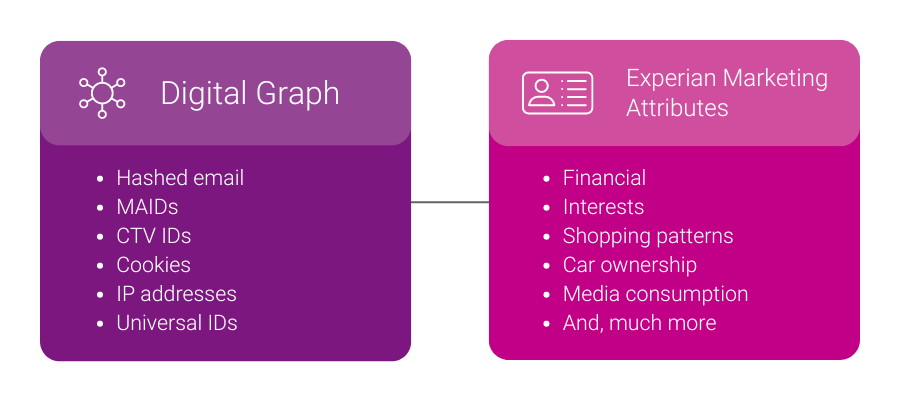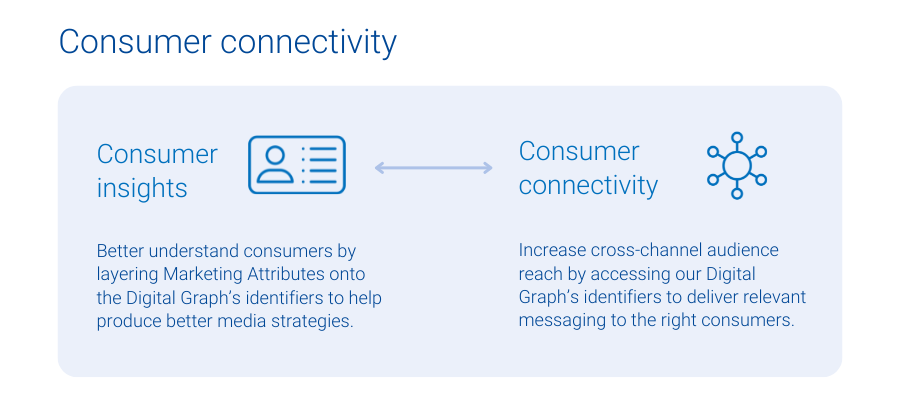
Experian, the leader in powering data-driven advertising through connectivity, is thrilled to unveil our latest solution, Digital Graph and Marketing Attributes. This joint solution supplies marketers and platforms with the insights and connectivity needed to understand who their customers are and reach them across digital channels.
The uncertainty around third-party cookies in Chrome and the overall decline in signal complicates the industry’s ability to reach the right consumer. Omnichannel media consumption results in scattered data, making it harder for marketers and platforms to understand consumer behavior and reach them across channels. These challenges call for a comprehensive solution.
Our Digital Graph and Marketing Attributes solution addresses these challenges by providing identifiers for seamless cross-channel engagement. By adding Marketing Attributes, like demographic and behavioral data, marketers and platforms also gain a better understanding of their customers. This solution uses Experian’s Living Unit ID (LUID) to combine offline and digital data, giving customers deeper insights into consumer behavior, greater audience reach, and improved cross-channel visibility.

Benefits of Digital Graph and Marketing Attributes
Both our Digital Graph and Marketing Attributes provide value to clients as standalone products. When clients license our Digital Graph and Marketing Attributes joint solution, they have more data at their fingertips, unlocking:
- Consumer connectivity: When clients license Experian’s Digital Graph, they get access to digital identifiers like mobile ad IDs (MAIDs), connected TV (CTV) IDs, hashed emails (HEMs), and universal IDs so they can target the right consumers with the relevant messages across all digital media channels.
- Consumer insights: Experian’s 5,000 Marketing Attributes provide our clients with detailed consumer information and insights, such as age, gender, purchase behaviors, and content consumption habits. Marketing Attributes help clients create more relevant messaging and informed audience segmentation.

Client examples
How OpenX offers richer targeting and more connectivity with Experian
OpenX is an independent omni-channel supply-side platform (SSP) and a global leader in audience, data, and identity-targeting. With industry-leading technology, exceptional client service, and extensive scalability across all formats, including CTV, app, mobile web, and desktop, OpenX has a legacy of innovating products that enhance buyer outcomes and publisher revenue while addressing complex challenges in programmatic.
In recent years, OpenX has licensed Experian’s Digital Graph with identifiers, contributing to the SSP’s largest independent supply-side identity graph, which offers advanced audiences to buyers and improved data resolution to content owners.
More recently, OpenX licensed Experian’s Marketing Attributes to enrich its supply-side identity graph, which includes IPs, MAIDs, and client IDs, with a variety of attributes. This strategic move has helped OpenX’s clients benefit from enhanced consumer insights and addressability, in turn delivering greater reach to the demand side and higher revenue for publishers, despite industry signal loss.
“We built on our long-term partnership with Experian to enrich our digital IDs with Experian’s Marketing Attributes, which help provide buyers better insights to audiences, thereby helping our publishers monetize their inventory. With partners like Experian, OpenX effectively facilitates the value exchange between demand and supply, ensuring our partners are able to drive results for their business in the era of signal loss”
Craig Golaszewski, Sr. Director of Strategic Partnerships, OpenX
How StackAdapt licenses our product bundle to address three different use cases
StackAdapt is the multi-channel programmatic advertising platform trusted by marketers to deliver exceptional campaigns. They drive superior results through a variety of solutions, like contextual and first-party targeting, brand lift measurement, and optimization through insights.
StackAdapt licensed a similar yet unique product combination, our Digital Graph and our Audiences. StackAdapt uses the Digital Graph to allow clients to onboard their first-party data in a seamless, self-serve manner that allows them to further segment their data using Experian Audiences.
“StackAdapt has been recognized as the most trusted programmatic platform by marketers, and with the integration of Experian’s Digital Graph and Audiences, we are strengthening our leadership in the space. This partnership improves our ability to deliver precise cross-channel segmentation, reach, and measurement, helping advertisers run more successful campaigns. Our collaboration with Experian allows us to offer a differentiated solution in the market and ensure our clients can deliver the most precise and impactful ads to their audiences.”
Denis Loboda, Senior Director of Data, StackAdapt
We recently announced a new partnership with StackAdapt. This collaboration brings the power of Experian’s identity graph, syndicated and custom audiences directly to the StackAdapt platform. Read the full details in our press release here.
Four ways to use Digital Graph and Marketing Attributes
When these two products come together, our clients have a 360-degree view of their consumers, which helps them power four critical use cases:
- Analytics and insights: Learn more about your consumers by connecting our Marketing Attributes with our Digital Graph’s identifiers. For example, a retailer can discover that their recent customers over-index as pickleball fans and players, leading the retailer to sponsor a professional pickleball event.
- Inventory monetization: When supply-side partners know their audience better, they can attract advertisers in search of that audience. For example, a publisher might find out that their audience is full of pickleball fans, leading them to reach out to brands that want to reach this audience.
- Activation: Companies with access to more digital identifiers from our Digital Graph can reach more people, while controlling frequency across channels. A company might know that they want to reach pickleball fans. Now, they have the digital identifiers needed to reach pickleball fans across all digital channels where they consume content, leading to increased reach.
- Measurement and attribution: Use the Digital Graph’s support for various digital identifiers to understand all consumer touchpoints, from media impressions to conversions. Then, lean on our Marketing Attributes to determine who your messaging resonated with. For example, a company uses our Digital Graph to know if it was the same individual who was exposed to an ad on CTV and converted via e-commerce. On top of that, the company can use our Marketing Attributes data to find out that the people who purchased were overwhelmingly pickleball fans.
Connect with us to learn more about how our Digital Graph and Marketing Attributes joint solution can provide the data and insights you need to create, activate, and measure cross-channel media campaigns.
Latest posts

Partnership leverages industry-leading Tapad Device Graph™ for more effective video marketing across all connected devices NEW YORK, April 11, 2017 /PRNewswire/ – Tapad, a part of Experian, the leading provider of privacy-safe, cross-device marketing technology solutions, has announced its partnership with Innovid, the world's leading video marketing platform. This integration enables Innovid to bring cross-device personalization and a more unified viewer experience to its video marketing clients including Bank of America, L'Oréal, Microsoft and Procter & Gamble. Innovid's proprietary technology is the only platform optimized for video, enabling marketers to thrive in an ever-changing digital television landscape. Since its launch last year, Innovid's Marketing Cloud Suite has helped marketers increase message relevance and the opportunity to drive conversions, retention and acquisition through video personalization. By leveraging the Tapad Device GraphTM, Innovid's marketers can now benefit from the ability to drive consistent, personalized user experiences across all devices, creating more impactful connections with consumers and increasing ROI. "Personalization is a must for every data-driven marketer and really needs to happen across all devices to ensure a unified customer journey," says Ronnie Lavi, SVP of product at Innovid. "At Innovid, we recognize one size does not fit all when it comes to video. As an open platform, we are always looking to add best-of-breed capabilities through integrations and partnerships, and we've chosen Tapad because of its superior cross-device expertise." "Innovid has long paved the way for effective personalization in the video marketing space," says Pierre Martensson, GM of Tapad's data division. "As video continues to gain popularity across digital formats, we're excited to see how our technology empowers Innovid to bring that renowned personalization to more customers across all of their devices." Contact us today!

Tracey Scheppach's new marketing and media practice leverages Tapad's device-level data to help clients achieve "marketing nirvana" NEW YORK and CHICAGO, April 5, 2017 /PRNewswire/ — Today, Tapad, now part of Experian, is the leading provider of unified, cross-screen marketing technology solutions, and Matter More, a next generation marketing and media practice with deep experience in the advanced TV space, announced a strategic partnership to bring together world class digital data and audience development expertise to help marketers improve how they connect with consumers. As consumer behavior continues to expand across multiple devices, today's marketers need robust, comprehensive data solutions to accurately engage the people who matter most to their brands. At the same time, the TV industry has reached an advertising tipping point, capitalizing on the power of device-level data. "Achieving unduplicated reach and frequency across all channels with true addressability, and the ability to measure outcomes, is marketing nirvana," says Tracey Scheppach, CEO and co-founder of Matter More, a new agency built for the modern age. "The best opportunity to deliver 'marketing nirvana,' at scale, is by partnering with Tapad and using their world-class Device Graph to help our clients simply matter more to the people they care about most." "By leveraging our access to rich TV data, we can now measure the actual performance of media across channels," says Marshall Wong, SVP, TV for Tapad. Tapad's proprietary Device Graph™ unifies consumer behavior data across all devices, uncovering the interests, passions and behaviors of the audiences who matter most. As with any data solution, privacy, transparency and trust are crucial to bringing marketers a solid offering that delivers results. "Tapad is excited to partner with Matter More to tap into their knowledge base and experience working with some of the largest brands on TV today," says Kate O'Loughlin, SVP and GM of Tapad's media division. "The time has come to truly unleash the power of device-level data at scale." Contact us today

Verizon announced that they will be closing down their email business and migrating users to AOL over the next few months. With such an impending deadline it is important for email marketers to take action and consider the following steps to keep valuable email subscribers. Create a separate segment of all Verizon email addresses in your email automation platform. This will give insight into the size and ratio of this segment compared to your overall subscribers and helps you determine your strategy on acquiring their new email address. In your email campaigns make sure to use direct language in the subject line, the pre-header and header banner requesting that users update their email address either in a preference center or for them to create a new account If possible, make sure to link both the Verizon and new email address in your data-set to ensure that they are not treated as new when receiving future communication. As part of your email campaign strategy, be sure to target those who have not yet opened the email. We recommend sending two follow up emails using the previously created banners, and altering the subject line to encourage subscribers to take action. It is important to note that Verizon service users have been advised that they will keep their @verizon.net email domain if they switch over to AOL. If the user does not opt-in to the AOL service, then their email will be shut down and will subsequently bounce – if this happens then these should be removed from your dataset accordingly. For more information check out Verizon’s website here. If you are a client and have additional questions, please contact your manager or email us directly.